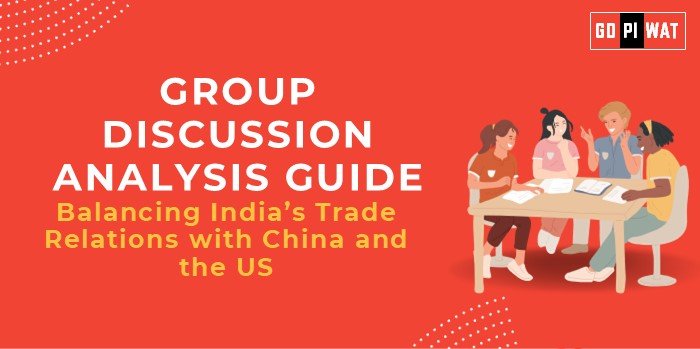📋 Group Discussion Analysis Guide: Balancing India’s Trade Relations with China and the US
🌐 Introduction to the Topic
Opening Context: Balancing trade relations between China and the US is a crucial diplomatic and economic challenge for India. These two nations represent the world’s largest economies and India’s top trading partners, but their geopolitical rivalry poses unique risks and opportunities.
Topic Background: India’s trade ties with China grew significantly after economic liberalization, particularly in manufacturing and electronics. Meanwhile, partnerships with the US have flourished in IT, defense, and services. The escalating US-China trade tensions and the global economic shifts compel India to strategically navigate this dynamic for its growth.
📊 Quick Facts and Key Statistics
🇺🇸 India-US Trade: Exceeded $191 billion in 2022; US is India’s largest export destination.
📉 Trade Deficit: India has a $100 billion trade deficit with China, while enjoying a $39 billion trade surplus with the US.
💰 FDI Inflows: US firms contributed 18% of India’s FDI, while Chinese investments have slowed due to geopolitical concerns.
🤝 Stakeholders and Their Roles
- 🏛️ Indian Government: Balancing trade policies, negotiating tariffs, and promoting self-reliance via “Make in India.”
- 🏭 Chinese Enterprises: Key suppliers for Indian manufacturing, especially electronics and machinery.
- 💼 US Corporations: Major buyers of IT services and suppliers of advanced technologies.
- 🏗️ Indian Industries: Facing challenges in competing with Chinese imports and expanding exports to both markets.
🏆 Achievements and Challenges
✨ Achievements:
- 🌐 Diversified Partnerships: Strong relations with the US in tech and defense; reliance on China for manufacturing inputs.
- 📜 Policy Initiatives: Introduction of PLI schemes to reduce Chinese dependency.
- 📈 Increased US Trade: Shift of some supply chains from China to India post-COVID-19.
⚠️ Challenges:
- 📉 Trade Deficit with China: Heavily skewed imports, especially in electronics and pharmaceuticals.
- 🌍 Geopolitical Pressures: Navigating the US-China trade war while preserving strategic autonomy.
- 🔗 Dependence on Both Markets: Risk of economic fallout from either side in the event of sanctions or political disputes.
🌍 Global Comparisons:
- 🇻🇳 Vietnam: Successfully balanced trade ties with both nations by positioning itself as a manufacturing hub.
- 🇦🇺 Australia: Leveraged its commodity exports to China while securing defense ties with the US.
🗣️ Structured Arguments for Discussion
Supporting Stance: “India’s strategic policies, such as ‘Make in India’ and Free Trade Agreements with the US, enable it to balance these crucial relationships effectively.”
Opposing Stance: “India’s heavy reliance on Chinese imports and the complex nature of US-China rivalry make balancing trade relations a daunting task.”
Balanced Perspective: “While India has made strides in diversifying partnerships, achieving a true balance requires reducing overdependence on Chinese imports and strengthening domestic manufacturing.”
💡 Effective Discussion Approaches
- 📊 Opening Approaches:
- Cite trade statistics to emphasize the economic stakes.
- Highlight India’s strategic initiatives like the PLI scheme.
- Use a case study like Vietnam’s success in balancing its trade.
- 🛠️ Counter-Argument Handling:
- Emphasize solutions like supply chain diversification and regional trade agreements.
- Highlight India’s efforts to secure strategic autonomy through balanced policies.
📈 Strategic Analysis of Strengths and Weaknesses
- 🏅 Strengths: Strong IT services, rising manufacturing capacity, strategic alliances with both nations.
- ⚠️ Weaknesses: High trade deficit with China, overdependence on US for advanced technologies.
- 💡 Opportunities: Shift of global supply chains, regional trade alliances.
- ⚡ Threats: Geopolitical tensions, trade restrictions, and global economic slowdown.
🎓 Connecting with B-School Applications
- 📚 Real-World Applications: Relevant to supply chain management, international finance, and trade strategy case studies.
- 💬 Sample Interview Questions:
- “How can India use FTAs to balance its trade relations?”
- “Evaluate the impact of the US-China trade war on Indian exports.”
- 🔑 Insights for B-School Students: Explore projects on geopolitical risk assessment, supply chain shifts, and trade strategy.


